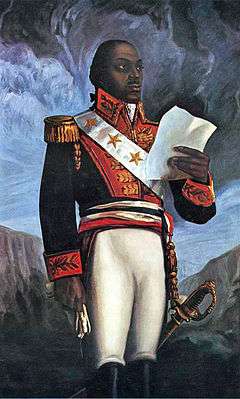Baptist War
| Christmas Rebellion | |||||||
|---|---|---|---|---|---|---|---|
| Part of North American slave revolts | |||||||
_Destruction_of_the_Roehampton_Estate_January_1832.png) Destruction of the Roehampton Estate, January 1832, by Adolphe Duperly | |||||||
| |||||||
| Belligerents | |||||||
| Rebel slaves | |||||||
| Commanders and leaders | |||||||
|
| Samuel Sharpe | ||||||
| Strength | |||||||
| Unknown | 60,000 | ||||||
| Casualties and losses | |||||||
| 14 killed | 207 killed | ||||||
| North American slave revolts |
|---|
 |
|
The Baptist War, also known as the Christmas Rebellion, the Christmas Uprising and the Great Jamaican Slave Revolt of 1831–32, was an eleven-day rebellion that mobilized as many as 60,000 of Jamaica's 300,000 slaves.[1] It was led by a black Baptist preacher, Samuel Sharpe, and waged largely by his followers.
Ideology
The missionary-educated rebels had been following progress of the abolitionist movement in London; their intention was to call a peaceful general strike.[2] Compared with their Presbyterian, Wesleyan, and Moravian counterparts, Baptist slaves seemed more ready to take action. This may have reflected a higher level of absenteeism among white Baptist missionaries. The relative independence of Black deacons[2] facilitated slaves taking greater ownership over their religious life, including reinterpretations of Baptist theology in terms of their own experience (for example, they placed an emphasis on the role of John the Baptist, sometimes at the expense of Jesus Christ.[3])
Thomas Burchell, a missionary in Montego Bay, returned from England following Christmas vacation. Many of the Baptist ministry expected that he would return with papers for emancipation from King William. They also thought that the King's men would enforce the order. Thus, discontent escalated among slaves when the Jamaican governor announced that no emancipation had been granted.[4]
The strike
Led by 'native' Baptist preacher, Samuel Sharpe, blacks demanded more freedom and a working wage of "half the going wage rate"; they took an oath to stay away from work until their demands were met by the plantation owners. Upon refusal of their demands, slaves escalated the strike into a full rebellion. It became the largest slave uprising in the British West Indies,[4] mobilizing as many as 60,000 of Jamaica's 300,000 slaves.[1] Fourteen whites were killed by armed slave battalions during the course of the rebellion, and 207 rebelling slaves were killed.[5]
Suppression and death toll
The rebellion was suppressed with relative ease by British forces, under the control of Sir Willoughby Cotton.[6] The reaction of the Jamaican government and reprisals of the plantocracy[2] were far more brutal. Approximately 500 slaves were killed in total: with 207 killed outright during the revolt. After the rebellion an estimated 310 to 340 slaves were killed through "various forms of judicial executions," at times, for quite minor offences (one recorded execution was for the theft of a pig; another, a cow).[7] An 1853 account by Henry Bleby described how the courts commonly executed three or four persons simultaneously; bodies were piled up until workhouse negroes carted the bodies away at night and bury them in mass graves outside town.[4]
After the rebellion, property damage was estimated in the Jamaican Assembly summary report in March 1832 at £1,154,589 (equaling roughly £52,000,000 in modern terms).[5]
The planters suspected many missionaries of having encouraged the rebellion. Some, such as William Knibb, were arrested but later released. Groups of white colonials destroyed chapels that housed slave congregations.[8]
Aftermath
The brutality of the Jamaican plantocracy during the revolt is thought to have accelerated the British process of emancipation. Parliament passed a law for initial measures to begin in 1833, followed by partial emancipation (outright for children six or under, six years apprenticeship for the rest) in 1834, and then unconditional emancipation of chattel slavery in 1838.
In literature
- Andrea Levy's 2010 novel The Long Song recounts, through a fictional narrative, the events of the Baptist War.
- The 1929 novel The White Witch of Rosehall, by Herbert G. de Lisser, has a climax set at the time of the Baptist War.
Notes
- 1 2 Barry W. Higman, "Slave Populations of the British Caribbean, 1807–1834", Journal of Interdisciplinary History, Vol. 16, No. 2 (Autumn, 1985), pp. 365–367
- 1 2 3 Craton, Michael. Testing the Chains: Resistance to Slavery in the British West Indies (Cornell University Press, 1983), pp. 297–98
- ↑ Turner, Mary. Slaves and Missionaries: The Disintegration of Jamaican Slave Society, 1787–1834 (University of Illinois Press, 1982), p. 81
- 1 2 3 Révauger, Cécile (October 2008). The Abolition of Slavery – The British Debate 1787–1840. Presse Universitaire de France. pp. 107–108. ISBN 978-2-13-057110-0.
- 1 2 Turner (1982) p.121
- ↑ "An End to Slavery – 1816–1836: Jamaica Reluctantly Makes History by Freeing its Slaves".
- ↑ Mary Reckord. "The Jamaican Slave Rebellion of 1831", Past & Present (July 1968), 40(3): pp. 122, 124–125.
- ↑ Masters, P., 2006: Missionary triumph over slavery. Wakeman Trust, London. ISBN 1-870855-53-1. pp17-23
Further reading
- Craton, Michael: The Economics of Emancipation: Jamaica and Barbados, 1823–1843 (University of North Carolina Press, Chapel Hill 1995).
- Heuman, Gad: "A Tale of Two Jamaican Rebellions," in: Jamaican Historical Review (1996), 19: pp. 1–8.
- Hochschild, Adam. Bury the Chains: The British Struggle to Abolish Slavery. Houghton Miffin, New York 2005. pp. 338–343.
- Morrison, Doreen: Slavery's Heroes: George Liele and the Ethiopian Baptists of Jamaica 1783-1865, 2004, CreateSpace. ISBN 978-1500657574.
- Reckord, Mary: The Jamaican Slave Rebellion of 1831. Past and Present (July 1968), 40(3): pp. 108–125.
- Rodriguez, Junius P. (ed.): Encyclopedia of Slave Resistance and Rebellion, Westport 2006, CT: Greenwood.
- Short, K.R.M.: "Jamaican Christian Missions and the Great Slave Rebellion of 1831–2," in: Journal of Ecclesiastical History, (1976), 27(1): pp. 57–72.
- Turner, Mary: Slaves and Missionaries : The Disintegration of Jamaican Slave Society, 1787–1834 (University of Illinois Press, 1982).